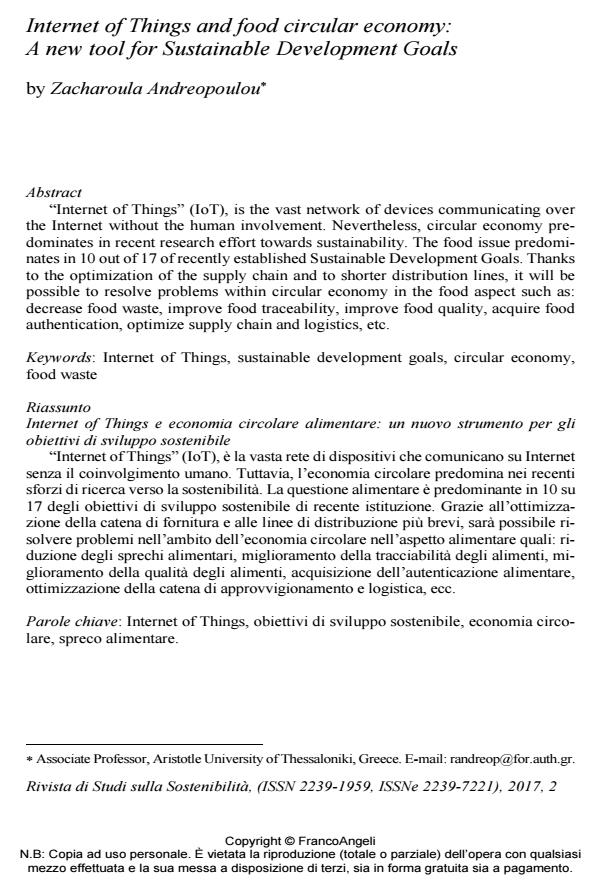Internet of Things and food circular economy: A new tool for Sustainable Development Goals
Journal title RIVISTA DI STUDI SULLA SOSTENIBILITA'
Author/s Zacharoula Andreopoulou
Publishing Year 2017 Issue 2017/2
Language English Pages 7 P. 43-49 File size 134 KB
DOI 10.3280/RISS2017-002004
DOI is like a bar code for intellectual property: to have more infomation
click here
Below, you can see the article first page
If you want to buy this article in PDF format, you can do it, following the instructions to buy download credits

FrancoAngeli is member of Publishers International Linking Association, Inc (PILA), a not-for-profit association which run the CrossRef service enabling links to and from online scholarly content.
"Internet of Things" (IoT), is the vast network of devices communicating over the Internet without the human involvement. Nevertheless, circular economy predominates in recent research effort towards sustainability. The food issue predominates in 10 out of 17 of recently established Sustainable Development Goals. Thanks to the optimization of the supply chain and to shorter distribution lines, it will be possible to resolve problems within circular economy in the food aspect such as: decrease food waste, improve food traceability, improve food quality, acquire food authentication, optimize supply chain and logistics, etc.
Keywords: Internet of Things, sustainable development goals, circular economy, food waste
- Voluntary traceability in food supply chain: a framework leading its implementation in Agriculture 4.0 Maria Elena Latino, Marta Menegoli, Mariangela Lazoi, Angelo Corallo, in Technological Forecasting and Social Change 121564/2022 pp.121564
DOI: 10.1016/j.techfore.2022.121564 - Linking circular economy and digitalisation technologies: A systematic literature review of past achievements and future promises Chetna Chauhan, Vinit Parida, Amandeep Dhir, in Technological Forecasting and Social Change 121508/2022 pp.121508
DOI: 10.1016/j.techfore.2022.121508 - Industry 4.0 and circular economy: An exploratory analysis of academic and practitioners' perspectives Maurizio Massaro, Silvana Secinaro, Francesca Dal Mas, Valerio Brescia, Davide Calandra, in Business Strategy and the Environment /2021 pp.1213
DOI: 10.1002/bse.2680 - The individual and integrated impact of Blockchain and IoT on sustainable supply chains:a systematic review Pankaj Dutta, Rahul Chavhan, Pogala Gowtham, Amrinder Singh, in Supply Chain Forum: An International Journal /2023 pp.103
DOI: 10.1080/16258312.2022.2082851 - The circular economy: A broader perspective for rural areas Rosanna Salvia, Zacharoula S. Andreopoulou, Giovanni Quaranta, in RIVISTA DI STUDI SULLA SOSTENIBILITA' 1/2018 pp.87
DOI: 10.3280/RISS2018-001008 - Comparing Recyclers and Non-Recyclers to Foster Pro-Environmental Behavior Ioanna Ligoudi, Evangelia Karasmanaki, Georgios Tsantopoulos, in Earth /2025 pp.47
DOI: 10.3390/earth6020047
Zacharoula Andreopoulou, Internet of Things and food circular economy: A new tool for Sustainable Development Goals in "RIVISTA DI STUDI SULLA SOSTENIBILITA'" 2/2017, pp 43-49, DOI: 10.3280/RISS2017-002004